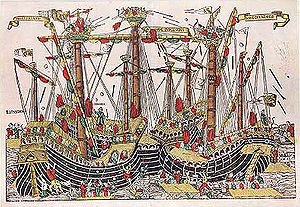- Ottoman–Venetian War (1499–1503)
-
Second Ottoman–Venetian War Part of the Ottoman–Venetian Wars 
The Battle of ZonchioDate 1499–1503 Location Adriatic, Ionian and Aegean Seas Result Ottoman victory Territorial
changesVenetian strongholds of Modon and Coron fall to the Ottomans; Cephalonia and Ithaca to Venice Belligerents  Republic of Venice
Republic of Venice
 Spain
Spain Ottoman Empire
Ottoman EmpireCommanders and leaders  Antonio Grimani
Antonio Grimani
 Gonzalo de Córdoba
Gonzalo de Córdoba Kemal Reis
Kemal ReisThe Ottoman–Venetian War of 1499–1503 refers to the naval battles between the Ottoman Empire and the Republic of Venice for the control of lands that were contested between the two parties in the Aegean Sea, Ionian Sea and the Adriatic Sea.
The Turks, under the command of Admiral Kemal Reis, were victorious in these conflicts and forced the Venetians to finally recognize the Ottoman gains in 1503, after Turkish cavalry raids reached Venetian territory in Northern Italy.
Contents
The war
1499
In January 1499, Kemal Reis set sail from Istanbul with a force of 10 galleys and 4 other types of ships, and in July 1499 met with the huge Ottoman fleet which was sent to him by Davud Pasha and took over its command in order to wage a large-scale war against the Republic of Venice. The Ottoman fleet consisted of 67 galleys, 20 galliots and circa 200 smaller vessels. In August 1499, Kemal Reis defeated the Venetian fleet under the command of Antonio Grimani at the Battle of Zonchio (also known as the Battle of Sapienza or the First Battle of Lepanto). It was the first naval battle in history with cannons used on ships, and took place on four separate days: on August 12, 20, 22 and 25, 1499. After reaching the Ionian Sea with the large Ottoman fleet, Kemal Reis encountered the Venetian fleet of 47 galleys, 17 galliots and circa 100 smaller vessels under the command of Antonio Grimani near Cape Zonchio and won an important victory. During the battle, Kemal Reis sank the galley of Andrea Loredan, a member of the influential Loredan family of Venice. Antonio Grimani was arrested on 29 September but was eventually released. Grimani later became the Doge of Venice in 1521. The Ottoman Sultan Bayezid II gifted 10 of the captured Venetian galleys to Kemal Reis, who stationed his fleet at the island of Cefalonia between October and December 1499.
1500
In December 1499, the Venetians attacked Lepanto with the hope of regaining their lost territories in the Ionian Sea. Kemal Reis set sail from Cefalonia and re-took Lepanto from the Venetians. He stayed in Lepanto between April and May 1500, where his ships were repaired by an army of 15,000 Ottoman craftsmen brought from the area. From there, Kemal Reis set sail and bombarded the Venetian ports on the island of Corfu, and in August 1500 he once again defeated the Venetian fleet at the Battle of Modon (also known as the Second Battle of Lepanto). Kemal Reis bombarded the fortress of Modon from the sea and captured the town. He later engaged with the Venetian fleet off the coast of Coron and captured the town along with a Venetian brigantine. From there Kemal Reis sailed towards the Island of Sapientza (Sapienza) and sank the Venetian galley Lezza. In September 1500, Kemal Reis assaulted Voiussa and in October he appeared at Cape Santa Maria on the Island of Lefkada, before ending the campaign and returning to Istanbul in November. With the Battle of Modon, the Turkish fleet and army quickly overwhelmed most of the Venetian possessions in Greece. Modon and Coron, the "two eyes of the Republic", were lost. Doge Agostino Barbarigo asked the Pope and the Catholic Monarchs for help, and on 24 December a Spanish–Venetian army commanded by Gonzalo de Córdoba took Cephalonia, temporarily stopping the Ottoman offensive on eastern Venetian territories.
See also
External links
Categories:- 15th-century conflicts
- 16th-century conflicts
- Ottoman–Venetian Wars
- 15th century in Greece
- 16th century in Greece
Wikimedia Foundation. 2010.
